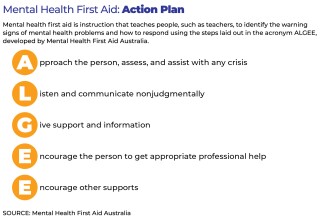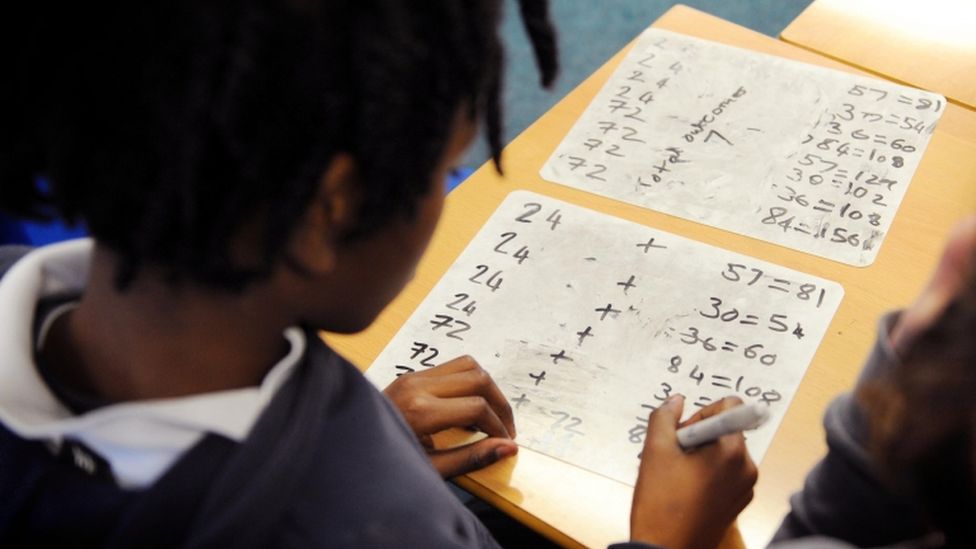

The nation’s schools were already struggling to meet students’ mental health needs when the pandemic hit. How can schools rise to meet students’ ballooning needs in that area as a massive school reopening gets underway?
To be sure, it will be difficult to balance mental health support with an equally massive academic recovery. But child development experts say it’s a balance schools must attempt to strike if they want students to regain their academic footing after an unprecedented year of disruptions, stress, and trauma.
An infusion of federal COVID-19 relief money will help, but how those funds are used will be pivotal. And experts say that schools cannot just focus on the students they know are in crisis; they must bolster supports for all students as well as staff members.

Even before the pandemic, mental health disorders, such as anxiety and depression, were on the rise among children and adolescents and many schools were struggling to keep pace with that demand. Suicide rates among children 10 and older had also climbed significantly since 2007, making suicide the second leading cause of death among adolescents before the pandemic.
And the pandemic certainly hasn’t made things easier for kids.
Felecia Evans, a principal at Lander Elementary in Mayfield Heights, Ohio, just outside Cleveland, said her students are struggling with family housing loss, job loss, food insecurity, and just general anxiety about what may come next. Thirty percent of Evans’ students come from low-income households.
“My student support team, myself, my school psychologist, the school counselor, my assistant principal, we meet every week with our ‘high watch list’ of kids,” she said. “And it’s kind of changed the nature of my work. We used to spend a lot more time being able to talk about teaching and learning and now it’s really trying to problem solve and help people get access to resources.”null
Nationally, the number of young children and adolescents going to the emergency room because of a mental-health crisis has shot up during the pandemic, according to the U.S. Centers for Disease Control and Prevention.
More students are asking for services through their schools, a recent EdWeek Research Center survey of teenagers found. Twenty-one percent of high schoolers said that during the pandemic they felt for the first time they would benefit from school-based mental health services.
But professional organizations such as the National Association of School Psychologists, the American School Counselor Association, and the National Association of School Nurses say that there are not enough support staffs in schools—at least not now.
NASP recommends a ratio of 500 students per school psychologist, but the national average is actually closer to 1,500 to one. The American School Counselor Association recommends a ratio of 250 students to one school counselor, but the national average in the 2018-19 school year, the most recent year for which data was available, was 430 students per school counselor. Only about half of the nation’s schools have a dedicated full-time nurse, while the National Association of School Nurses advocates for one full-time nurse in each school building.
How federal relief money can help
Some states and districts have already committed to using their share of the $129 billions of dollars in federal COVID-19 relief aid to hire more school psychologists and counselors.
While some districts may be reluctant to hire new staff, whether it be school psychologists, counselors, social workers, or nurses, with funds that will run out in a few years, it may be a bet worth making, said Rob Coad, a school psychologist and a member of the National Association of School Psychologists’ School Safety and Crisis Re
Once schools, students, and parents get something they find valuable, he figures, it can be hard to take away.
“Our hope is that as you use this stimulus money to build support in schools, [these services] become normalized, and then the sites and ultimately the district see the value in it, and they reallocate and protect money to continue that over the long haul,” he said.
There are many other ways schools can expand their mental health services with the help of federal aid, such as using telehealth to connect students to mental health-care providers and training for teachers and staff on how to identify and respond to children who may be struggling with mental health issues, said Phyllis Jordan, the editorial director at FutureEd, a think tank based at Georgetown University.

“Another issue: You’re going to have some discipline problems this year,” said Jordan. “There are going to be kids who have behavioral outbursts, and you’re just going to have kids who are out of practice at being in school who are just not behaving properly. And the worst thing a school can do is flush them all out with suspensions or harsh discipline. There is going to have to be some attention and training on issues like restorative practices and ways of coping with these issues that kids are going to have.”
For districts that haven’t invested in a social-emotional learning curriculum, now, with this infusion of federal dollars, would be a good time to do so, said Jordan.
Schools can also tap personnel or volunteers from their community or a program such as AmeriCorps to mentor students, said Jordan. Research has shown that positive relationships play an important role in developing students’ ability to cope and learn.null
Jordan also recommends that schools consider either starting or stepping up teacher home visits, which are a powerful way to develop relationships with families and gain a thorough understanding of what students are facing in their home lives and the suppor they have outside of school.

STUDENT WELL-BEINGHow to Build Relationships With Students During COVID-19Arianna Prothero,
If schools are not in a position to go on a hiring spree or invest in, say, a new social-emotional learning curriculum, there are other steps they can take to make a difference, said Coad.
“This is a difficult time to try to start over and establish a new curriculum because students and teachers have been asked to pivot yet again.” Schools have more capacity to help students than they may realize, he said.“If a school is struggling, it’s probably more of a process of reallocating resources rather than not having them. We have to remind our fellow professionals about the skills that they have that help us screen and triage students that are in need.”
School partnerships with community mental health providers are another strategy for bolstering the supports students can access through school.
Finally, climate surveys are a low-resource tool schools can use to assess the mental health needs of their students as they return to classes at the end of summer, said Jordan. Even if a school already uses school climate surveys, Jordan recommends passing a survey out at the start of the academic year and adding additional, pandemic-specific questi

On mental health, schools must move from responding to preventing
Whatever route schools go, they should invest in prevention as well as in responding to children who are already in a state of crisis, said Sharon Hoover, a professor of child and adolescent psychiatry at the University of Maryland School of Medicine and co-director of the National Center for School Mental Health.null
While students will in most cases benefit greatly from more support staff such as counselors and psychologists, schools also need to have strong systems of universal supports in place, she said. For example, they should be teaching mental health literacy in all grades.
“This really should be a core part of your curriculum …teaching kids how to obtain and sustain positive mental health, understand mental illness, and how to seek help if they need it,” said Hoover. “Then as you think of moving up that triangle of support, investing in some kind of assessment system. Some people call it well-being check-ins. Some people call it mental health screening, but just a way to identify how your students are doing and if and when they need additional mental health support.”
Similar to screening for vision and hearing problems in school, said Hoover, if schools don’t have the staff in-house, they can refer students to a provider.
Another important component to prevention and universal supports is social-emotional learning.
While not a replacement for other mental health supports such as therapy, social-emotional learning can help root efforts to improve mental health schoolwide, said Stephanie Andrews, the interim executive director of student and family support services at Tulsa public schools.
“I don’t want anyone to think that if we do self-awareness, that we’re going to get rid of depression,” she said. But social-emotional learning can teach children how to name and express what they are feeling. “I think having emotional literacy is really important, just as important as academic vocabulary.”
Identifying emotions is key to tackling the tough ones, said Andrews, something that students—and oftentimes even adults—need help learning how to do.
SEL exercises such as “feelings circles” and “mood meters” can give students the space to examine their emotions and develop the vocabulary they need to express them and ask for help when they need them.
Another crucial piece to providing mental health supports school wide is teacher well-being.
“We can’t have healthy students if we don’t have a healthy education workforce,” said Hoover. “And so that is one thing that schools should be thinking about as they are considering how to support student mental health. They first have to assess and address educator well-being.”
One way the Tulsa school system has tackled this was by setting up a hotline specifically for teachers and principals to call when they’re stressed or overwhelmed.

SCHOOL & DISTRICT MANAGEMENT Teachers’ Mental Health Has Suffered in the Pandemic. Here’s How Districts Can Help Catherine Gewertz,
At Lander Elementary School in Ohio, principal Evans believes giving teachers breathing room and time for collaboration is an important part of well-being. She has eked out more time for planning and professional development for teachers during the pandemic by reorganizing the entire school day and week. Her campus has been teaching students in-person for most of the school year.
When they started in September, Evans lumped the school’s special courses for each grade—physical education, music class, art, and maker spaces—into a designated day during the week. For example, on Monday, all 1st graders start and end the day with their home teacher, but spend the rest of the day in special classes and lunch. On Tuesday, the schedule rotates to the 2nd graders, and so forth.
This system frees up a four-hour block of time, including lunch, for teachers in each grade level once a week. They use the time to meet with their other grade-level teachers and game out an academic plan for the upcoming week, reflect on what’s working and what’s not, discuss students who are struggling, participate in professional development, touch base with parents, and conduct one-on-one assessments for the few students who are learning remotely.null
“I have seen them grow as collaborative teams because they don’t feel like they are on an island or on this constant treadmill,” said Evans. “With the curve balls that COVID has thrown us, just being able to count on … consolidated time with a team of people has been important for them.”
Evans also moved back the start time for students’ school day. Students and teachers used to start at the same time, and giving teachers an hour in the morning to prepare before the kids arrive has also helped with teacher self-care and morale, she said.
While Evans said her school could benefit from more direct mental health resources (at the top of her wish list is on-site, five-day-a-week therapy for students and families), this new schedule has gone a long way to provide more support for Lander’s teachers.
And it’s been popular with teachers, like Nicole Rucci-Macauda, who teaches 3rd grade.
“I think that’s helped everbody’s mental health because you’re not as rushed,” she said. “You have time to look deeper into other things—to meet with parents, to meet with a counselor for one of your students and talk about strategies and things like that.”
The union was hesitant when she pitched this reordered schedule last summer, Evans said, but the teachers have since embraced it. And Lander Elementary will continue to operate on the same schedule, with minor tweaks, next school year.














